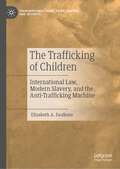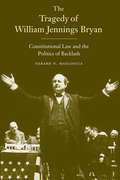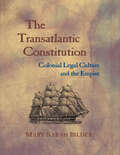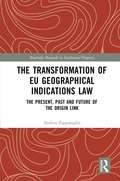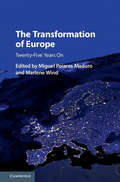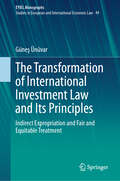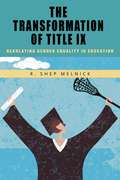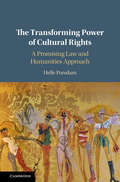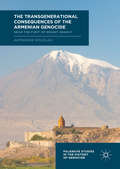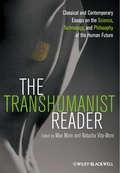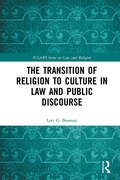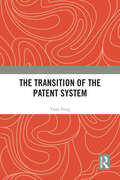- Table View
- List View
The Trademark Guide: How You Can Protect and Profit from Trademarks (Third Edition) (Allworth Intellectual Property Made Easy)
by Lee Wilson"A highly accessible text." —Lawyers Weekly A User-Friendly Handbook on Understanding Trademarks Trademarks are a crucial part of the American economy. In plain language with scores of real-life examples, this new edition of The Trademark Guide draws on Wilson's experience and addresses issues important to both would-be trademark owners and those who already own trademarks, including: How to choose a trademark without risking a lawsuit How trademark rights are gained and perfected How to use a trademark properly What constitutes trademark infringement What to do if your trademark is infringed How trademark law applies to new media And much more Completely updated to reflect recent court decisions and changes in the law, this edition features an Internet trademark resources list and expanded information on trademarks in the digital world. Packed with examples, FAQs, and a glossary, The Trademark Guide, Third Edition, will become the go-to for anyone with questions about the complexities of trademark law.
The Tradition and Modern Transition of Chinese Law
by Jinfan ZhangThe book was first published in 1997, and was awarded the first prize of scientific research by the Ministry of Justice during the ninth Five-Year Plan of China. In 2005, it was adopted the text book for the postgraduates of law majors. In 2009, it was awarded the second prize of the best books on law in China. The book discusses from different aspects the long legal tradition in China, and it not only helps us to have a further understanding of Chinese legal system but also combines theories and practice and illustrate the modern legal transition which probes the history of Chinese legal system. As is known to us all, China is a country with a long legal history, which can be traced back to more than three thousand year ago. So the legal tradition of China has been passed down from generation to generation without any interruptions. This feature is peculiar to Chinese legal history which is beyond all comparison with that of other countries such as ancient Egypt, ancient India, ancient Babylon and ancient Persia. Through the study of Chinese legal history we can have a deeper understanding of the histories, features, origins and the transition of Chinese legal tradition. The Chinese legal tradition originated from China, and it is the embodiment of the wisdom and creativity of Chinese civilization. The great many books, researching materials, legal constitutions, archives, files and records of different dynasties in China have provided us with rare, complete and systematic materials to research. The book has a complete, systematic and detailed research on Chinese legal tradition and its transition and it gives people a correct recognition of the process of the perfection of laws during its development and its position as well as its value in the social progress in order to grasp its regular patterns. It also has showed us the most valuable part and core of Chinese legal Tradition and it is a summary of Chinese legal tradition and its transition from different perspectives, different angles and different levels. From the book, we can see that the ancient Chinese Legal Culture had once shocked the world and exerted great influence on the civilization of the world legal system, especially the legal systems in Asian countries. The book also has discussed the reestablishment of law in the late Qing Dynasty and the beginning of the Chinese law's transition to modernity. In a word, the book has not only combined the legal system and the legal culture together, but also integrated the important historical figures and events ingeniously and it is a valuable and readable book with authenticity.
The Trafficking of Children: International Law, Modern Slavery, and the Anti-Trafficking Machine (Transnational Crime, Crime Control and Security)
by Elizabeth A. FaulknerThe phenomenon of child trafficking holds a unique position as an issue of significant contemporary relevance, occupying a principal place in debates about human rights today. The interchangeable terms trafficking and modern slavery evoke emotive responses and proclamations about abolition of contemporary ills, viewed as the ultimate aberration when a child is involved. The classification of children under legal frameworks marks them as different, as ‘other’, and in the context of laws implemented to address trafficking, slavery, and children on the move more generally, this distinction is complicated.This book charts the emergence, decline and re-emergence of child trafficking law and policy during the twentieth and twenty-first centuries. It provides a systematic and comprehensive overview of the historical origins of child trafficking by utilising the wealth of information located within the non-digitised archives of the League of Nations. It focusses upon the Committee on the Traffic in Women and Children to engage with League of Nations policy to provide an insightful and original contribution to the current body of literature. This is a book that seeks to critique the entanglements of children’s rights and colonialism in relation to the mobility and exploitation of children. It centralises the legacy of colonialism, the undercurrents of race, white supremacy, patriarchy, and their ongoing influence upon contemporary anti-trafficking legal and policy responses. Through utilizing what the author identifies as the ‘anti-trafficking machine’ as a theoretical framework, the book challenges contemporary law and policy responses to child trafficking. This theoretical framework has been adopted to illustrate a central hypothesis of the book – that the contemporary anti-trafficking agenda is both imperialist and a continuity of colonial attitudes.
The Tragedy of William Jennings Bryan: Constitutional Law and the Politics of Backlash
by Gerard N. MaglioccaAlthough Populist candidate William Jennings Bryan lost the presidential elections of 1896, 1900, and 1908, he was the most influential political figure of his era. In this astutely argued book, Gerard N. Magliocca explores how Bryan's effort to reach the White House energized conservatives across the nation and caused a transformation in constitutional law. Responding negatively to the Populist agenda, the Supreme Court established a host of new constitutional principles during the 1890s. Many of them proved long-lasting and highly consequential, including the "separate but equal" doctrine supporting racial segregation, the authorization of the use of force against striking workers, and the creation of the liberty of contract. The judicial backlash of the 1890s--the most powerful the United States has ever experienced--illustrates vividly the risks of seeking fundamental social change. Magliocca concludes by examining the lessons of the Populist experience for advocates of change in our own divisive times.
The Trans-Pacific Partnership
by Patrick Low C. L. Lim Deborah K. ElmsThe Trans-Pacific Partnership (TPP) talks attempt to link together at least nine countries in three continents to create a 'high-quality, twenty-first century agreement'. Such an agreement is intended to open markets to competition between the partners more than ever before in sectors ranging from goods and services to investment, and includes rigorous rules in the fields of intellectual property, labour protection and environmental conservation. The TPP also aims to improve regulatory coherence, enhance production supply chains and help boost small and medium-sized enterprises. It could transform relations with regions such as Latin America, paving the way to an eventual Free Trade Area of the Asia Pacific, or see innovations translated into the global trade regulatory system operating under the WTO. However, given the tensions between strategic and economic concerns, the final deal could still collapse into something closer to a standard, 'twentieth-century' trade agreement.
The Transatlantic Constitution: Colonial Legal Culture and the Empire
by Mary Sarah Bilder“One of the more significant recent pieces of scholarship in this area . . . essential reading for all students of early America.” —Journal of American History Departing from traditional approaches to colonial legal history, Mary Sarah Bilder argues that American law and legal culture developed within the framework of an evolving, unwritten transatlantic constitution that lawyers, legislators, and litigants on both sides of the Atlantic understood. The central tenet of this constitution—that colonial laws and customs could not be repugnant to the laws of England but could diverge for local circumstances—shaped the legal development of the colonial world.Focusing on practices rather than doctrines, Bilder describes how the pragmatic and flexible conversation about this constitution shaped colonial law: the development of the legal profession; the place of English law in the colonies; the existence of equity courts and legislative equitable relief; property rights for women and inheritance laws; commercial law and currency reform; and laws governing religious establishment. Using as a case study the corporate colony of Rhode Island, which had the largest number of appeals of any mainland colony to the English Privy Council, she reconstructs a largely unknown world of pre-Constitutional legal culture.“The book is rich in social history as well, with the evolving status of women and institutional religion providing much of the legal grist.” —Choice
The Transcendent Character of the Good: Philosophical and Theological Perspectives (Routledge Studies in Ethics and Moral Theory)
by Petruschka SchaafsmaThis volume addresses issues of moral pluralism and polarization by drawing attention to the transcendent character of the good. It probes the history of Christian theology and moral philosophy to investigate the value of this idea and then relates it to contemporary moral issues. The good is transcendent in that it goes beyond concrete goods, things, acts, or individual preferences. It functions as the pole of a compass that helps orient our moral life. This volume explores the critical tension between the transcendent good and its concrete embodiments in the world through concepts like conscience, natural and divine law, virtue, and grace. The chapters are divided into three parts. Part I discusses metaphysical issues like the realist nature and the unity of the good in relation to philosophical, naturalist, and theological approaches from Augustine to Iris Murdoch. The chapters in Part II explore issues about knowing the transcendent good and doing good, exemplified in the delicate balance between divine command and human virtuousness. Early Protestant theological views prove to be excellent interlocutors for this reflection. Finally, Part III focuses on how transcendence is at stake in two heavily debated moral issues of today: euthanasia and the family. The Transcendent Character of the Good will be of interest to scholars and advanced students working in theological ethics, moral philosophy, and the history of ethics. The Open Access version of this book, available at www.taylorfrancis.com, has been made available under a Creative Commons Attribution-Non Commercial-No Derivatives 4.0 license.
The Transformation of Criminal Justice: Philadelphia, 1800-1880 (Studies in Legal History)
by Allen SteinbergAllen Steinberg brings to life the court-centered criminal justice system of nineteenth-century Philadelphia, chronicles its eclipse, and contrasts it to the system -- dominated by the police and public prosecutor -- that replaced it. He offers a major reinterpretation of criminal justice in nineteenth-century America by examining this transformation from private to state prosecution and analyzing the discontinuity between the two systems.Steinberg first establishes why the courts were the sources of law enforcement, authority, and criminal justice before the advent of the police. He shows how the city's system of private prosecution worked, adapted to massive social change, and came to dominate the culture of criminal justice even during the first decades following the introduction of the police. He then considers the dilemmas that prompted reform, beginning with the establishment of a professional police force and culminating in the restructuring of primary justice.Making extensive use of court dockets, state and municipal government publications, public speeches, personal memoirs, newspapers, and other contemporary records, Steinberg explains the intimate connections between private prosecution, the everyday lives of ordinary people, and the conduct of urban politics. He ties the history of Philadelphia's criminal courts closely to related developments in the city's social and political evolution, making a contribution not only to the study of criminal justice but also to the larger literature on urban, social, and legal history.Originally published in 1989.A UNC Press Enduring Edition -- UNC Press Enduring Editions use the latest in digital technology to make available again books from our distinguished backlist that were previously out of print. These editions are published unaltered from the original, and are presented in affordable paperback formats, bringing readers both historical and cultural value.
The Transformation of EU Geographical Indications Law: The Present, Past and Future of the Origin Link (Routledge Research in Intellectual Property)
by Andrea ZappalaglioLinking traditional and local products to a specific area is increasingly felt as a necessity in a globalised market, and Geographical Indications (GIs) are emerging as a multifunctional tool capable of performing this and many other functions. This book analyses the evolving nature of EU sui generis GIs by focusing on their key element, the origin link, and concludes that the history of the product in the broad sense has become a major factor to prove the link between a good and a specific place. For the first time, this area of Intellectual Property Law is investigated from three different, although interrelated, perspectives: the history and comparative assessment of the systems of protection of Indications of Geographical Origin adopted in the European jurisdictions from the beginning of the 20th century; the empirical analysis of the trends emerging from the practice of EUGIs; and the policy debates surrounding them and their importance for the fulfilment of the general goals of the EU Common Agricultural Policy. The result is an innovative and rounded analysis of the very nature of the EU Law of GIs that, starting from its past, investigates the present and the likely future of this Intellectual Property Right. This book provides an interesting and innovative contribution to the field and will be of interest to GI scholars and Intellectual Property students, as well as anyone willing to gain a better understanding of this compelling area of law.
The Transformation of EU Treaty Making: The Rise of Parliaments, Referendums and Courts since 1950 (Cambridge Studies in European Law and Policy)
by Imelda Maher Dermot HodsonTreaty making is a site of struggle between those who claim the authority to speak and act on the international stage. The European Union (EU) is an important test case in this respect because the manner in which the Union and its member states make treaties has shifted significantly over the last six decades. Drawing insights from EU law, comparative constitutionalism and international relations, this book shows how and why parliaments, the people and courts have entered a domain once dominated by governments. It presents qualitative and quantitative evidence on the importance of public trust and political tactics in explaining this transformation of EU treaty making and challenges the idea that EU treaties are too rigid. Analysing legal developments in the EU and each of its member states, this will be essential reading for those who wish to understand the EU's controversial experiment in treaty making and its wider significance.
The Transformation of Europe: Twenty-Five Years On
by Miguel Maduro Marlene WindJoseph Weiler's The Transformation of Europe is one of the most influential works in the history of European studies. Twenty-five years after its original publication, this new collection of essays pays tribute to Weiler's legacy by discussing some of the most pressing issues in contemporary European Union law, policy and constitutionalism. The book does not intend to be a simple expression of intellectual esteem for Weiler's seminal work; instead, the collection honours it by critically engaging with some of its assumptions and theses. Overall, it shows how a study of 1991 can still be fundamental to the present and future of the EU, including the challenges of Brexit and Eurozone crises.
The Transformation of European Private Law
by James Devenney Mel B. KennyThis book emanates from a duo-colloquium which explored the Europeanisation of private law in the context of efforts to consolidate the consumer acquis, the Draft Common Frame of Reference, the appointment of an Expert Group on a Common Frame of Reference in the area of European contract law, the passage of the Consumer Rights Directive and the proposed Common European Sales Law. This book, with fully updated contributions, critically reflects on whether the process of Europeanisation, which has shaped private law in the EU Member States, has now reached a significant turning point in its development, a point of punctuated equilibrium. Written by a team of leading authors, the topics covered will be of concern in all European legal systems and beyond.
The Transformation of Global Health Governance
by Colin Mcinnes Kelley Lee Simon Rushton Owain David Williams Adam Kamradt-Scott Anne Roemer-MahlerThe authors examine how health governance is being transformed amid globalization, characterized by the emergence of new actors and institutions, and the interplay of competing ideas about global health. They explore how this has affected the governance of specific health issues and how it relates to global governance more broadly.
The Transformation of International Investment Law and Its Principles: Indirect Expropriation and Fair and Equitable Treatment (European Yearbook of International Economic Law #44)
by Güneş ÜnüvarThis book explores how international investment law has evolved through the interpretation of key protection standards like Fair and Equitable Treatment and indirect expropriation. It examines how arbitral decisions have shaped, and been shaped by, state treaty-making practices - particularly in recent "new generation" agreements. The analysis reveals a broader trend toward greater clarity, specificity, and balance in the design of investment treaties. "Güneş Ünüvar skillfully combines a voluntarist approach to the making of international investment law, and the practical reality that arbitral tribunals are the main interpreters of the volonté of the States, thereby shaping the field as much as, or perhaps more than, the States themselves. Ünüvar&’s analysis of the development and evolution, both in cases and treaties, of the two most-used investment protection norms is a unique and compelling contribution to understanding the law and policy of investment law and arbitration. A must-read." Prof. Eric de Brabandere, Leiden University "This book is an important contribution to the thinking about the international investment regime. It looks at the regime dynamically, reflecting on how it has developed historically and how the outcome of disputes has shaped the responses of governments in their treaty making. This book will be important reading for everybody thinking critically about the regime, whether in academia or in government. It is all the more relevant for the work of UNCITRAL Working Group III which has to think both about which reforms to develop, but also how to ensure that adjustments can be made in the future." Colin Brown, European Commission "Güneş Ünüvar offers an insightful perspective on the evolving landscape of international investment law. By examining the dynamic relationship between arbitration and treaty-making, this book sheds light on how protection standards like fair and equitable treatment and indirect expropriation are shaped through practice and interpretation. Ünüvar&’s analysis is both thoughtful and accessible, shedding light into complex ideas about legal certainty, legitimacy, and normative development." Prof. Ursula Kriebaum, University of Vienna "An important contribution to international investment law. In The Transformation of International Investment Law and its Principles, Güneş Ünüvar does a remarkable job of integrating treaty practice and arbitral case law into a comprehensive and accessible study of investment law&’s most important standards." Prof. Catharine Titi, The French National Centre for Scientific Research (CNRS)
The Transformation of Private Law – Principles of Contract and Tort as European and International Law: A Liber Amicorum for Mads Andenas (LCF Studies in Commercial and Financial Law #2)
by Maren HeidemannEminent lawyers from academia, international judiciary and legal practice join up to honour Professor Mads Andenas KC (Hon). Contributions form a cutting edge volume across legal disciplines led by an advisory editorial committee including Prof. Guido Alpa, Prof. Carl Baudenbacher, Prof. Eirik Bjorge, Prof. Giuseppe Conte and Prof. Duncan Fairgrieve.The general private law of tort and delict is subject to a transformation where the traditional national framework is becoming gradually less relevant. Much of the modernisation of private law takes place not at the domestic level but at a European or international level such as in international commercial conventions or EU consumer protection legislation. Remedies in regulatory law are becoming ever more important. The role of the European Court of Justice in developing general principles of contract and tort is ever increasing. Tort liability is an important subject of international conventions with the caselaw of the International Court of Justice developing general principles of tort liability in public international law.
The Transformation of Property Regimes and Transitional Justice in Central Eastern Europe
by Liviu DamşaThis volume examines the property transformations in post-communist Central Eastern Europe (CEE) and focuses on the role of restitution and privatisation in such transformations. It argues that the theorisation of 'restitution' in post-communist CEE is incomplete in the transitional justice scholarship and in the literature on correction of historical wrongs. The book also argues that, for a more complete theorisation of (post-communist) restitution, the transformations of property in post-communist societies ought to be studied in a more holistic way. The main legal vehicles used for such transformations, privatisation and restitution, should not be studied separately and in abstract, but in their reciprocal relationship, and in connection to the dimension of justice which each could achieve. Finally, the book integrates 'privatisation' in a theory of post-communist transformation of property.
The Transformation of Title IX: Regulating Gender Equality in Education
by R. Shep MelnickIn this book, the author analyzes how interpretations of "equal educational opportunity" have changed over the years. In terms accessible to non-lawyers, the author examines how Title IX has become a central part of legal and political campaigns to correct gender stereotypes, not only in academic settings but in society at large. Title IX thus has become a major factor in America's culture wars―and almost certainly will remain so for years to come.
The Transformation of the Supreme Court of Canada
by Donald R. SongerIn the last half-century, the Supreme Court of Canada has undergone major upheaval. The most drastic change occurred with the adoption of the Charter of Rights in 1982, which substantially increased the Court's role in resolving controversial political and social issues. The Transformation of the Supreme Court of Canada examines the impact of institutional changes on the proceedings and decisions of the Court from 1970 to 2003. The first book on the Supreme Court to incorporate extensive in-depth interviews with former justices, this study provides both insiders' accounts of how decisions are made and an empirical analysis of more than 3,000 Court decisions. Drawing on this extensive commentary and statistical data, Donald R. Songer demonstrates that the Court has remained a politically moderate and democratic institution despite its considerable power and influence. The most comprehensive account of its kind to date, The Transformation of the Supreme Court of Canada makes a significant contribution to the literature and will be of particular interest to scholars and students of judicial behaviour and comparative law.
The Transforming Power of Cultural Rights: A Promising Law and Humanities Approach
by Helle PorsdamCultural rights promote cultural and scientific creativity. Transformative and empowering, they also enable the pursuit of knowledge and understanding, thereby working as atrocity prevention tools. The Transforming Power of Cultural Rights argues that this gives these rights a central role to play in promoting the full human personality and in realizing all other human rights. Looking at the work of the UN Special Rapporteurs in the field of cultural rights as well as UNESCO's efforts, Helle Porsdam addresses the question of how a universal human rights agenda can include a dialogue that recognizes the importance of cultural diversity without sliding into cultural relativism. She argues that cultural rights offer a useful international arena and discourse in which to explain and negotiate cultural meanings when controversies arise. This places them at the center of human rights - and at the center of law and humanities.
The Transgenerational Consequences of the Armenian Genocide: Near The Foot Of Mount Ararat (Palgrave Studies in the History of Genocide)
by Anthonie HolslagThis book brings together the Armenian Genocide process and its transgenerational outcome, which are often juxtaposed in existing scholarship, to ask how the Armenian Genocide is conceptualized and placed within diasporic communities. Taking a dual approach to answer this question, Anthonie Holslag studies the cultural expression of violence during the genocidal process itself, and in the aftermath for the victims. By using this approach, this book allows us to see comparatively how genocide in diasporic communities in the Netherlands, London and the US is encapsulated in an historic narrative. It paints a picture of the complexity of genocidal violence itself, but also in its transgenerational and non-spatial consequences, raising new questions of how violence can be perpetuated or interlocked with the discourse and narratives of the victims, and how the violence can be relived.
The Transhumanist Reader: Classical and Contemporary Essays on the Science, Technology, and Philosophy of the Human Future
by Max More Natasha Vita-MoreThe first authoritative and comprehensive survey of the origins and current state of transhumanist thinking The rapid pace of emerging technologies is playing an increasingly important role in overcoming fundamental human limitations. Featuring core writings by seminal thinkers in the speculative possibilities of the posthuman condition, essays address key philosophical arguments for and against human enhancement, explore the inevitability of life extension, and consider possible solutions to the growing issues of social and ethical implications and concerns. Edited by the internationally acclaimed founders of the philosophy and social movement of transhumanism, The Transhumanist Reader is an indispensable guide to our current state of knowledge of the quest to expand the frontiers of human nature.
The Transition of Religion to Culture in Law and Public Discourse (ICLARS Series on Law and Religion)
by Lori G. BeamanThis book explores the recent trend toward the transformation of religious symbols and practices into culture in Western democracies. Analyses of three legal cases involving religion in the public sphere are used to illuminate this trend: a municipal council chamber; a town hall; and town board meetings. Each case involves a different national context—Canada, France and the United States—and each illustrates something interesting about the shape-shifting nature of religion, specifically its flexibility and dexterity in the face of the secular, the religious and the plural. Despite the differences in national contexts, in each instance religion is transformed into culture or heritage by the courts to justify or excuse its presence and to distance the state from the possibility that it is violating legal norms of distance from religion. The cultural practice or symbol is represented as a shared national value or activity. Transforming the ‘Other’ into ‘Us’ through reconstitution is also possible. Finally, anxiety about the ‘Other’ becomes part of the story of rendering religion as culture, resulting in the impugning of anyone who dares to question the putative shared culture. The book will be essential reading for students, academics and policy-makers working in the areas of sociology of religion, religious studies, socio-legal studies, law and public policy, constitutional law, religion and politics, and cultural studies.
The Transition of the Patent System
by Yuan FengThis book investigates the institutionalized process, basic laws, and evolutionary trends of the patent system based on the analytical model of evolutionary theory and deploying a historical and comparative approach.Unlike traditional scholarship that focuses solely on the analysis of legal texts, this book considers the patent system to be both a historical product and an evolving institution that requires a synchronic study of its institutionalization. The author traces the emergence and evolution of the patent system by examining the concept and derivative systems during the pre-industrial age, the medieval period, and the industrial age respectively, as well as the challenges it faces nowadays. By exploring the influencing factors and roles of technology, economy, culture, and power that have determined and shaped the patent system throughout history, the book provides insights into the impetus, principles, and mechanisms of its formation and evolution, shedding light on its future and advancement.This title will greatly benefit students, researchers, legal professionals, and policymakers interested in intellectual property law and policy, particularly the patent system.
The Transition: Interpreting Justice from Thurgood Marshall to Clarence Thomas
by Daniel KielEvery Supreme Court transition presents an opportunity for a shift in the balance of the third branch of American government, but the replacement of Thurgood Marshall with Clarence Thomas in 1991 proved particularly momentous. Not only did it shift the ideological balance on the Court; it was inextricably entangled with the persistent American dilemma of race. In The Transition, this most significant transition is explored through the lives and writings of the first two African American justices on Court, touching on the lasting consequences for understandings of American citizenship as well as the central currents of Black political thought over the past century. In their lives, Thurgood Marshall and Clarence Thomas experienced the challenge of living and learning in a world that had enslaved their relatives and that continued to subjugate members of their racial group. On the Court, their judicial writings—often in concurrences or dissents—richly illustrate the ways in which these two individuals embodied these crucial American (and African American) debates—on the balance between state and federal authority, on the government's responsibility to protect its citizens against discrimination, and on the best strategies for pursuing justice. The gap between Justices Marshall and Thomas on these questions cannot be overstated, and it reveals an extraordinary range of thought that has yet to be fully appreciated. The 1991 transition from Justice Marshall to Justice Thomas has had consequences that are still unfolding at the Court and in society. Arguing that the importance of this transition has been obscured by the relegation of these Justices to the sidelines of Supreme Court history, Daniel Kiel shows that it is their unique perspective as Black justices – the lives they have lived as African Americans and the rooting of their judicial philosophies in the relationship of government to African Americans – that makes this succession echo across generations.


